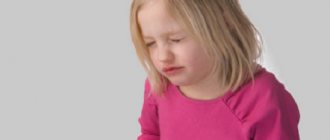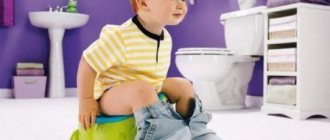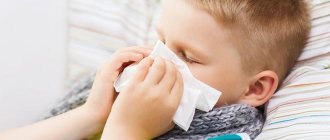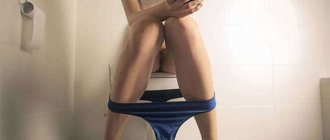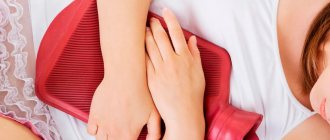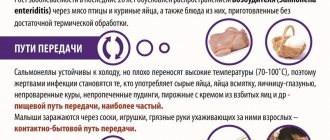- general information
- Symptoms
- What to pay attention to
- Cough during teething in children
- Diarrhea (diarrhea) during teething
- Vomiting during teething
- What temperature can it be during teething?
- Timing of teething
- The order of teething in children
- The order of eruption of molars in children
- Average time of appearance of molars
- How long does it take for upper and lower baby teeth to erupt?
- Average timing of appearance of baby teeth in the table
- How to make the teething process easier
- Teether toys
- Gum massage
- Applying ice
- Medicines for teething in children
- Gels for teething gums
- Ointments for gums
- Drops
- Summarizing the information of the article
Runny nose, cough, fever: teeth or cold?
Teething may be accompanied by a slight cough and fever, but since in the first two years of life there is a risk of various infections, you should not immediately attribute such symptoms to teething.
The child’s temperature rises due to the large amount of biologically active substances released in the area of tooth growth. Usually the temperature lasts 1-2 days and does not exceed 38-39°C. If the temperature exceeds 39°C or persists for more than two days, you should call a doctor.
Diarrhea appears in a child during this period due to strong salivation and accelerated intestinal motility. Babies' stools become watery and appear up to 2-3 times a day. If you experience watery diarrhea or bloody diarrhea more than three times a day, you should show your child to a doctor, it may be an intestinal infection.
A runny nose during this period is explained by the fact that the glands of the nasal cavity secrete a large amount of mucus. The discharge is clear and lasts no more than three days; there is no need to treat such a runny nose. The main thing is to clear the child’s nose of phlegm during the procedure. If nasal discharge becomes greenish, your nose is stuffy, or your runny nose lasts more than three days, you should consult a pediatrician.
A wet cough is explained by the fact that saliva accumulates in the child’s throat, which is secreted in large quantities during this period. The child coughs rarely, usually only when lying down. The cough usually goes away in two to three days. It does not require treatment. If a child coughs frequently, the cough is accompanied by wheezing in the bronchi, sputum production and shortness of breath, you should call a doctor. If you have the slightest doubt whether the symptoms that appear relate to teething or are these signs of some kind of disease, it is better to show the child to a specialist.
E. Komarovsky: does diarrhea come from teeth?
Diarrhea occurs quite often in teething babies. However, a well-known doctor reminds that the period of teething is a time of increased risk for the development of various intestinal infections, since the immune function of the baby’s body decreases, and due to the baby’s desire to constantly rub his teeth with any foreign objects, more microorganisms and viruses enter his gastrointestinal tract. And if, simultaneously with diarrhea, the baby’s body temperature rises, and the stool itself changes in consistency, smell and color, then most likely it is an infection, so the baby should be shown to a specialist as soon as possible.
Helping your baby during teething
Parents should support the baby during this period. You need to pick him up more often and distract him from the pain with interesting activities. While breastfed, the baby can easily calm down at his mother's breast. During this period, you should not stick to the schedule, much less try to wean your baby from the breast. Let the baby breastfeed more often than usual for a few restless days.
Since during this period children feel the urge to gnaw or chew something, offer the child a special rubber ring or a special toy - a teether. This can be any other object that the child himself has chosen, the main thing is to make sure that there are no sharp corners or small parts on it.
Sometimes the best way to make a child forget about pain is to play. Play with your baby, take a walk with him. Children tend to change their mood quickly. And during the game he will laugh happily, although a few minutes ago he was crying and capricious.
If a child’s gums hurt very badly, he cries a lot, and refuses to eat, you can use special gels to ease teething and eliminate pain (Kalgel, Kamistad). The gel is applied with your finger to the child’s gums several times a day.
When should you go to the pediatrician?
Medical care is needed for children who have started to develop an intestinal infection while teething.
You can judge this process by the following symptoms:
- the baby has a high body temperature;
- stool may turn green, streaked with blood and a lot of mucus;
- the stool has a putrid or sharp sour smell;
- the child's condition worsened, the baby became lethargic and refused to eat.
If your baby exhibits such signs, it is important to immediately consult a doctor to prevent dehydration and worsening of the condition. You should not treat the baby yourself, since dehydration in infants develops quite quickly.
mother of two children with medical education
The baby is teething!
Teething in children is a rather painful process. As a rule, it causes discomfort in the baby, which is expressed in increased anxiety, tearfulness and poor sleep.
Can teething cause bowel problems?
Everything is individual, but generally diarrhea can be a secondary sign of teething. For a very small organism, this is a severe physiological fracture.
Some children grow teeth painlessly, while others do not tolerate the teething period well.
If a child experiences teeth growing painfully, sleeps and eats poorly, and his temperature rises, then the following actions can help him:
- Treat your baby's gums with local anesthetics (Dentol, Dentinol), which contain the local anesthetic benzocaine.
- Use medications that work as antipyretics: Paracetamol, Ibuprofen. At normal temperatures, they do not affect it, but they have a pain-relieving effect!
Medical. They trust us with something priceless - children!
general information
Parents look forward to the appearance of a child's smile with teeth with special delight. The baby looks very cute with each new tooth, and very soon he will be able to chew food in full. Mothers feel joyful and excited during this period of their child’s life. Loving parents want to help their child cope with the unpleasant sensations that appear in the mouth. Each child is a unique individual, the course and symptoms are also different. You need to find out when the first tooth appears, what will appear in the child, whether it is possible to cope with the peculiarities of this process at home, or is it better to consult a doctor; Is this natural event occurring normally, or are there deviations and possible complications? There are many answers on the Internet, some true and some not so true. Let's figure out how to properly go through the process of teething in a child with minimal stress for him and for mommy.
Symptoms
Teething is a physiological stage of development for a baby. The symptoms at the beginning of teething are similar to a cold. Therefore, it is important to understand what set of symptoms indicates that baby teeth will soon appear.
- The first symptom that the mother pays attention to is swelling of the gums, and a hematoma may appear. The gums are swollen to the touch and look blue.
- The temperature rises and the baby’s general well-being worsens. In this case, you need to monitor how he behaves and feels. If the temperature does not decrease, you should consult a doctor.
- Salivation increases. This is beneficial for the gums, since saliva has bactericidal properties and prevents bacteria from multiplying.
- The child feels an unpleasant itch, he drags into his mouth any objects that come in his way.
- Decreased appetite. Eating causes discomfort, since the gums are traumatized by the teething process, and the child refuses to experience pain again when coming into contact with food.
- The child is capricious, rashes and spots appear on the skin around the mouth, as saliva secreted excessively gets on the skin and causes pain.
- Restless sleep due to discomfort in the gums.
- When the tooth can come out, white spots begin to appear on the gums. If you tap on the stains with a spoon, you will hear a sound characteristic of a tooth.
What to pay attention to
The appearance of baby teeth is one of the most uncomfortable periods in life. At the same time as the physiological natural process, colds and infectious diseases can occur. They need to be differentiated for successful treatment. If the symptom is the result of tooth growth, treatment is limited to reducing pain. In case of an infectious lesion, you need to find out the cause and select the appropriate treatment with your doctor. What parents need to remember during this time:
- If the body temperature is above 38.5 degrees and lasts longer than one day, this indicates the presence of viruses in the body. Only a doctor can prescribe medications to get rid of the disease.
- A cough accompanied by a high temperature, as well as a runny nose, indicate an infection.
- The presence of diarrhea and vomiting is a direct indication of a virus or poisoning.
- If a child is covered with a severe rash, this indicates an allergic reaction or a viral disease (exanthema).
Cough during teething in children
Excessive saliva production causes breathing difficulties. It is still difficult for a child to swallow saliva at an early age, so he reflexively begins to cough. Here the mother needs to be careful to distinguish this cough (which does not require treatment) from a cold, which needs to be treated with medication. Often the child coughs while lying down, as excessive saliva production makes breathing difficult. The secretion also gets into the nasal passages, and the child develops a runny nose. These are the consequences of excessive salivation.
Cough is not a constant symptom; if the cough with wheezing, fever, or runny nose does not go away, a visit to the doctor is necessary. You cannot let the course of the disease take its course.
Diarrhea (diarrhea) during teething
Diarrhea is a consequence of problems with the gastrointestinal tract. If a child swallows drool along with food, diarrhea is a reaction to viruses entering the body through the mouth. The appearance of new teeth in itself does not cause diarrhea, the connection is indirect.
- The secreted saliva partially enters the gastrointestinal tract and dilutes the feces, diarrhea appears as a consequence of this process.
- The gums swell and itch, the child intuitively wants to scratch his gums on some hard objects. This is an easy way of infection of the gastrointestinal tract, which contributes to the development of diarrhea.
- By the second half of the baby’s life, the mother introduces new complementary foods into the diet. If the child’s body cannot cope with the digestion of foods that are unusual for him, this can cause loose stools.
- Teething is stress for the body, and diarrhea is the human body’s response during this period.
Diarrhea cannot be called the main symptom of the teething process; it is one of several. A consultation will help eliminate the problem, identify the real cause, for which the doctor will select medications individually. You cannot self-medicate by giving your child immunomodulators or antiviral drugs without a doctor’s prescription. If the stool is green and there are inclusions, masses of foamy texture, if the child needs to use the toilet more than five times a day, you need to find a qualified specialist who will definitely prescribe the necessary treatment and conduct an examination to identify pathological processes.
Vomiting during teething
Vomiting does not indicate teething, nor is it an indicator of teething. Factors that provoke vomiting.
- Excessive salivation can irritate the uvula, and the body's response will be vomiting.
- Itching of the gums and the child’s desire to pull various objects into his mouth in order to chew is a potential factor in the occurrence of infection in the gastrointestinal tract. Vomiting is the body’s reaction to infection getting inside.
- If a child reacts by crying to discomfort in the gums, refuses to eat for a certain period of time, and then, when hungry, eats a lot, or takes large sips, this causes air to enter the stomach. The reaction to a large amount of food is vomiting.
- Colds with fever often cause vomiting.
- If a baby is force-fed, overfeeding may cause a gag reflex to develop.
From the above it is clear that there are many reasons for vomiting. It is not a consequence of this physiological process in the child’s life. It is possible to exclude situations preceding vomiting. For example, do not overfeed the child, do not force feed him, or while he is crying. Vomiting more than twice a day with a high body temperature at the same time indicates a possible infection, and the child should be taken to the doctor.
What temperature can it be during teething?
An increase in temperature is natural, since the gums are “cut” by the teeth and the integrity of the tissue is compromised. The temperature does not rise above 38-38.5 degrees. The child strives to get rid of the itching, uses improvised objects, toys, and puts them in his mouth. The likelihood of infection is very high.
The temperature rises slightly and lasts for a couple of days. If the fever does not subside, you need to show the baby to the doctor. An elevated temperature does not always occur, which means that this is not the main symptom of the appearance of new teeth.
Treatment of loose stools in an infant
Having determined the severity of the baby’s condition, the doctor decides to prescribe medications. The main goal of therapy is to prevent dehydration, additional infection and taking unnecessary medications.
Antibiotics are prescribed only in case of bacterial infection. Their uncontrolled intake will aggravate the situation, as will an excessive amount of sweets and fruit juices in the baby’s diet.
If diarrhea in children lasts a long time, the following will help get rid of it:
- drugs to slow down intestinal motility (reduce the number of daily bowel movements);
- prebiotics to normalize intestinal microflora;
- absorbents to normalize the intestinal walls;
- immunomodulators and vitamin complexes that increase the child’s body’s resistance to infections;
- drugs to prevent dehydration (normalize acid-base balance).
With the permission of a doctor, you can use traditional medicine recipes. Taking decoctions of chamomile and sage soothes the sensitive digestive system and has an antibacterial effect. You can make a mixture of honey and dried ginger root powder and offer it to your child once every 4-5 hours.
Chamomile decoction and other folk remedies can only be used with the permission of a doctor.
How to help a baby?
The best option for helping children under one year of age is drinking with an oral dehydration solution. However, diarrhea is often associated with other symptoms, which can cause a new mother to sound the alarm. Based on the condition of the baby, treatment tactics are selected:
- if the child looks lethargic and has a fever, you should give him medications based on ibuprofen and paracetamol;
- in the first 3 days you should not get rid of indigestion with drugs that can stop it (Stopdiar and others), the body can cope on its own;
- if there is an accompanying runny nose, you should use vasoconstrictor drops recommended by your doctor (more details in the article: how to treat a runny nose due to teething?);
- if irritation appears on the baby’s skin due to liquid feces, it is necessary to protect the epidermis with panthenol cream;
- if your gums itch, you need to buy a teether;
- You should not give your baby crackers and other hard foods (the baby may choke on an accidentally broken piece);
- it is not always possible to immediately recognize pathology by the type of stool, with the exception of impurities of blood and mucus;
- green stool should alert you, however, it can also be a variant of the norm if foods high in iron were present in the baby’s diet (for more details, see the article: normal and healthy baby stool).
Doctor Komarovsky's opinion
Dr. Komarovsky considers it necessary to treat indigestion when it lasts more than 3 days. During this period, baby teeth come out and diarrhea gradually subsides. Do not delay treatment in abnormal cases:
- vomiting is added to the disorder;
- foamy stool, blood or mucus in the stool (we recommend reading: symptoms and treatment of foamy stool in a child);
- green diarrhea (more details in the article: what to do if a child has green diarrhea?);
- there is severe dehydration due to diarrhea;
- There is increased salivation, a runny nose, irritability, and lack of appetite.
Treatment tactics
For prolonged diarrhea and vomiting, you can use Regidron. It is also important that your baby drinks enough fluids
The first stage of getting rid of diarrhea in a child is to restore the deficiency of water and salts (see also: what to feed a child with diarrhea and other disorders?). The therapy lasts for 4-6 hours, during which the baby is soldered with a solution of salts and glucose. In case of mild dehydration and no vomiting, the baby initially needs to drink 200-800 ml. liquids. For a child weighing up to 6 kg. 200-400 ml is enough, weighing from 6 kg - 600-800 ml. The liquid is given in small portions at intervals of 5-15 minutes.
The second stage involves further replacement of fluid loss if indigestion persists. For mild dehydration, the baby needs an additional 50 ml. water per 1 kg. weight, with strong - 100 ml. For example, a baby with mild dehydration weighing 5 kg. You should drink 400 ml within 6 hours. Regidron solution, and then another 300 ml. in 6 hours. The regimen is used until stool normalization.
When the child gets better, you can switch to water, a decoction of dried fruits, herbs, weak tea, and pomegranate juice. If the baby asks to eat, you can give him breast or formula. Children over one year old should be given rice water, baked apples, crackers and bananas.
Causes of loose stools during teething
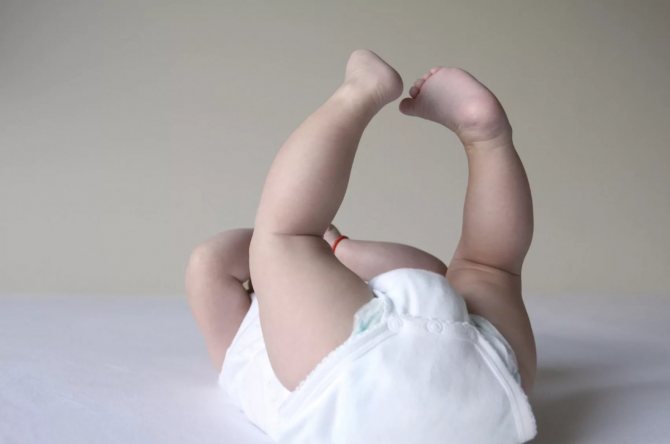
Diarrhea, along with a runny nose, high fever and vomiting, are possible common symptoms of teething. The appearance of all common symptoms at the same time is extremely rare and is a signal of a strong decrease in the body’s defenses. However, some deterioration in well-being can occur even in physically healthy children.
Vomiting and diarrhea during teething occur due to the inflammatory process in the oral cavity and increased salivation. Swallowing a large amount of saliva by the baby, the child’s nervousness and loss of appetite due to pain in the gums disrupt the digestion process.
Provoking factors are also:
- genetic predisposition;
- diseases of the gastrointestinal tract;
- reduced immunity;
- individual characteristics of the body.
Prevention
During teething diarrhea after 6 months of life, you need to follow the following tips:
- painkillers are used carefully after a doctor’s prescription and after reading the instructions;
- Antibiotics can only be prescribed by a doctor and it is strictly forbidden to give them to a child on your own;
- maintaining personal hygiene;
- Depending on your age, proper dental care is required;
- You cannot walk with a child who has a high temperature;
- When teeth are cutting through, you should not take your child to crowded places and invite friends to visit.
If you follow the pediatrician's recommendations correctly, the process of changing teeth will become less stressful for the baby. The appearance of an intestinal disorder requires special monitoring of the baby's health. If your stool changes, you should seek help from your pediatrician.
The process of teething is difficult for a baby. At this moment, all the functions of his organs also undergo changes, and viruses lie in wait for the baby everywhere.
Parents should know that diarrhea during primary teething does not last more than a day. Otherwise, there may be loose stools for several days, which is not normal.
Therefore, if a change in consistency and color is observed, urgent assistance from a specialist is required. If a child has previously erupted teeth, but not all of them have appeared, then the parents must provide special food.
How many days does diarrhea last during teething?
If loose stools occur periodically or last a couple of days, this is normal and you should not worry about it. If diarrhea lasts more than three days, you should consult a doctor, because the cause of diarrhea can be not only the appearance of teeth, but also the penetration of infection.
If the baby is healthy and a malfunction in the intestines occurs due to teething, the stool will normalize after the inflammation in the mouth disappears.
When is loose stool a reason to consult a pediatrician?

Parents need not worry if teething is accompanied by diarrhea with the following characteristics:
- Diarrhea does not bother the child;
- The frequency of bowel movements is no more than five times a day;
- The stool is of normal color without any mucus or blood.
If the diarrhea turns green or contains mucus, you should consult your pediatrician, as an intestinal infection or other gastrointestinal disease may have begun to develop.
The appearance of a high temperature and stool with a changed unpleasant putrefactive odor is a reason to immediately visit a pediatrician, especially if the child becomes lethargic, weak, and loses appetite.
So, you cannot do without medical help in the following cases:
- bowel movements more than 6 times a day;
- loose stools for more than 3 days;
- impurities appear in the stool;
- temperature rise above 38 degrees;
- The child is capricious and does not allow touching his stomach.
Consequences and complications of diarrhea during teething
Prolonged diarrhea is fraught with dehydration and disruption of water-salt metabolism, which affects the functioning of all organs and systems in the body. In severe cases, seizures or disruptions in the functioning of the heart, respiratory system, kidneys and central nervous system occur.
How to treat diarrhea during teething?
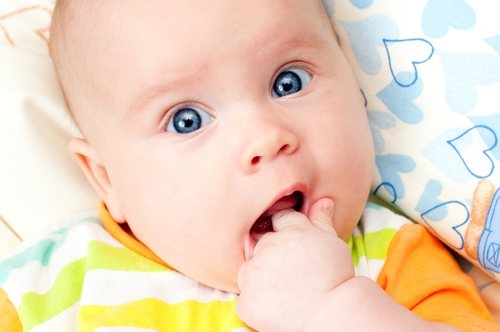
Treatment of diarrhea due to infection should be carried out by a pediatrician, but if the cause of the disease is teeth, therapy can be carried out at home. The following measures apply:
- Drink plenty of water - to prevent and treat dehydration, you need to give your baby plenty of water.
- You can use drugs that restore intestinal function: Linex for children, Bifiform Baby, Hilak-Forte, Bak-Set and Maxilak Baby.
- If the child is breastfeeding, the mother needs to follow a diet: exclude fresh berries and fruits, fatty foods and meat and add rice, jelly, dried fruit, bananas, low-fat soups and cereals to the diet.
Please note: you should not give your baby antibacterial drugs without a doctor’s advice!
Traditional methods of treating diarrhea
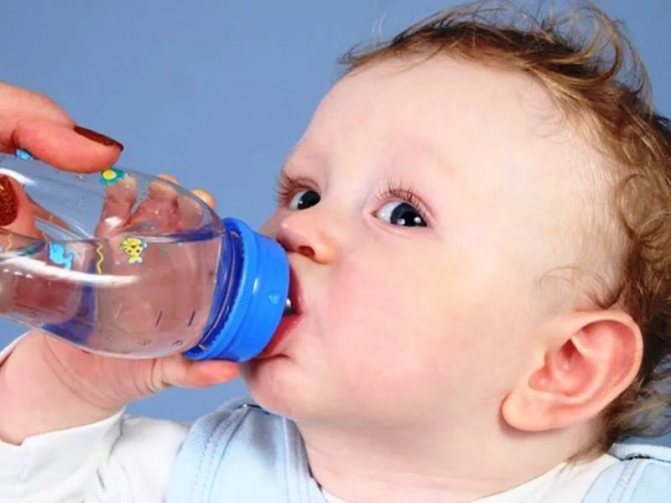
Traditional medicine recommends decoctions of medicinal herbs to strengthen stool:
- mint and chamomile tea;
- decoction of blueberries and hawthorn fruits;
- infusion of sage leaf.
Medicinal herbs will not only help with diarrhea, but will also calm the child, boost immunity, and eliminate inflammation. However, herbs have restrictions on age of use and health status, so before turning to traditional medicine, consult your pediatrician.
The process of teething in children can be quite complex. In case of diarrhea, you can use some medications, but first of all, you need to follow your diet. If you suspect any complications, contact your pediatrician.
What to do and how to treat it?
If parents are sure that diarrhea is a sign of teething and not an intestinal infection, then there is nothing particularly to worry about. Usually this problem goes away on its own within a few days. But doctors strongly recommend that you always get tested to exclude the possibility of infection of the child’s body.
Does this symptom need to be treated? The answer to this question cannot be unambiguous. It all depends on the cause of stool liquefaction and its frequency.
First, you should contact your pediatrician and complain about the symptoms that appear. Be sure to pay attention to additional signs.
If your baby is not sleeping well, has a runny nose and a fever, then the doctor must be notified. In most cases, treatment of this manifestation is symptomatic.
First, ask yourself the question: “How long does diarrhea during teething last?” If stool appears more than five times a day, it is worth giving the child a strengthening agent. The drug “Imodium” perfectly inhibits peristalsis. These tablets dissolve quickly in the mouth and begin to work within a few minutes.
Regardless of how many days diarrhea may last, every mother wants to alleviate the child’s condition. This problem does not require any special treatment. Some parents give antibiotics thinking it will help.
But this cannot be done.
In any case, first aid is provided to a child with loose stools. First, the baby needs to be provided with plenty of fluids. Loose stools will undermine the body's water balance, and inattention to the baby's condition will lead to unpleasant consequences.
The first thing parents need to do is to make sure whether the diarrhea is a consequence of teething. There are relative criteria when diarrhea can be considered as a normal reaction of the child’s body to teething:
- The development of diarrhea begins simultaneously with teething, as evidenced by redness and inflammation of the gums, the appearance of tubercles on them, and increased salivation.
- The temperature stays in the range of 37-37.5C, without decreases or surges.
- Loose stools during teething are closer to soft in consistency than watery; yellow in color, free of blood and mucus.
- Diarrhea lasts no more than 3 days, its frequency is no more than 4 times a day.
All of the above points are normal and do not require any serious treatment. First of all, this is not a reason to give your child antibiotics, since they will not only be useless in this situation, but will also contribute to the development of side effects such as dysbiosis, thrush, etc.
However, you can’t do nothing either; you need to at least somehow help the baby alleviate the condition. In this case, symptomatic and preventive treatment of diarrhea is recommended.
There is usually no need for drug treatment for diarrhea. Remember that children should not be given drugs that are popular among adults. So, for example, Loperamide should not be given to children under two years of age. If bloating occurs, you can give your baby Espumisan, or its equivalent.
It is recommended to give Regidron, but not all children like its taste, so the mother will have to be patient. If, after trying it yourself, you feel disgusted, and pity for the child gets the better of you, choose an alternative - it could be freshly brewed chamomile tea or plain boiled water.
https://www.youtube.com/watch?v=J00Wr4eDHAI
All medications must be given according to the instructions, observing the dosage. But we would recommend consulting a pediatrician first, since many of them have side effects.
Timing of teething
Fetal teeth are formed in utero when a pregnant woman is 8-16 weeks old. The formation of baby teeth in the buds occurs - ten on each jaw, and from the 20th week of pregnancy permanent teeth in the buds are formed. They are located under the milk in the gums.
The time it takes for teeth to erupt is different for all babies. There are cases where two teeth are visible immediately at birth. This is not a pathology. There are standard timings for teething. They take place in groups, deviation from the regular schedule drawn up by the researchers is possible within 1-2 months, and this is within the normal range.
The order of teething in children
The incisors on the lower jaw emerge first. They erupt in turn: first one, and then the second. Next come: lateral incisors, first molars, canines, second molars. The time at which a particular tooth will erupt is individual for each child. This growth of teeth and the symmetry of their appearance allows the formation of a correct antagonistic bite in the jaws. The harmonious development of the dentition is ensured.
The order of eruption of molars in children
The number of molars is greater. Instead of 20 dairy ones, there are 32 permanent ones. Sixes come out first; even before the loss of milk, the child receives paired constants. Teeth appear in pairs and in a certain sequence. There is a specific pattern for the order in which each tooth appears. Each child may have individual changes in timing. The dairy ones are replaced according to the same pattern as they appeared, and permanent ones take their place.
The best way to change dairy products to indigenous ones is the natural way. The roots of the first ones dissolve, allowing them to fall out, and permanent ones take their place. The jaw grows, providing space for permanent ones. It is not recommended to pull out breasts before they fall out on their own. This is how pathological malocclusion can develop. The baby teeth should fall out on their own, so that the jaw gradually grows evenly, and a physiological, correct bite is formed.
If milk does not fall out longer than expected, then it is recommended to remove them. To form an even bite, it is necessary to monitor the change of teeth; if some grow unevenly, see a doctor to make a decision on orthodontic treatment. Attentive attention to the health of dairy products will help preserve the condition of permanent ones. Any pathological conditions need to be treated and not left to chance; you should not take extreme measures and pull out a tooth.
Average time of appearance of molars
How long does it take for upper and lower baby teeth to erupt?
The total time it takes for the first set of teeth to appear completely is two and a half years. Teeth appear gradually, the process begins with the lower jaw, and continues with the appearance of paired units in turn. One tooth comes out every one to two months. They appear alternately from the lower and upper jaws, forming a harmonious bite. The time it takes for one tooth to appear varies from two days to one month. They may appear one at a time, or two at a time. The more teeth erupt in one period, the more difficult this process is for the child.
Average time for the appearance of baby teeth
| Age, months | Teeth |
| 1st medial incisors (central) on the lower jaw | |
| 1st medial incisors (central) on the upper jaw | |
| Lateral incisors at the top | |
| Lateral incisors below | |
| 1st molars at the top | |
| 1st molars below | |
| Fangs from above | |
| Fangs from below | |
| 2nd molars (large) from below | |
| 2nd molars (large) from above |
The dates given are averages, as each child has their own timing for teething. A difference of a couple of months is within normal limits. If the first tooth grows later, then the schedule for the rest also shifts. A full set of baby teeth appears by the age of three.
How to make the teething process easier
The emergence from the gums to the outside of the teeth is a long period, extended over time. It begins when the child is about six months old and lasts until the baby reaches three years of age. Parts of the gums swell, swell, and itch, which worries the baby. To solve these problems, you need to choose special toys for gum massage that help combat emerging symptoms.
Many different products have been invented for children that have not only gaming and developmental functions, but also therapeutic and preventive ones. For self-massage, there are toys with a textured surface. It is important to buy branded items, since manufacturers honestly indicate on the label the composition of what the product was made from. From this we can draw a conclusion about the benefits and safety for the child. This information is very important as he puts the toy in his mouth not only to explore it, but also to massage it himself. The child must come into contact with safe objects.
Teether toys
A teether is not only a children's toy, made in bright colors, equipped with educational elements. It is designed in such a way that the child can massage his gums while playing and exploring. The requirements for the design of such a toy are that it contains parts that will massage the child’s gums when he chews it. The teething toy is convenient in size for a child's hand. Medium sized parts.
Types of teethers:
- The classic silicone teether is made like a favorite toy, animal, or object. Bright colors, interesting shape and embossed texture meet all the requirements for self-massage during the game.
- The universal teether combines not only silicone parts, but also parts made of different textured materials, and serves as a multifunctional toy for a child.
- Rattle teether with sound effects for playing and distracting the child from discomfort.
- A variant of a teether that combines useful and pleasant properties is a nibbler. A bright teething toy that you can chew on while massaging your gums. It is shaped like a pacifier, there are holes in the design, and the device itself is hollow. You can put a fruit or vegetable inside. The taste of the product distracts the child from painful sensations, the texture of the teether massages the gums, relieving the condition.
- Gel or water teethers with a cooling effect. They are placed in the refrigerator for a while, and the child relieves discomfort from the gums.
- A toy with a vibration effect that starts from the first bite. A slight vibration relieves tension in the gums.
Dentists recommend teethers depending on the age of the child. Soft silicone toys are suitable for the youngest children when the frontal incisors have erupted. Then you can use medium-hard silicone and soft plastic. The shape of the toys is round or oval. When molars and canines and second molars come out, you should use toys of medium hardness, with protrusions on the sides.
The level of softness and hardness of the teether depends on the condition of the gums and the erupted units. The more teeth, the harder the material should be, since the child will already be gnawing on the toy. The shape of the massager that should be used varies depending on the location of the erupted units.
Gum massage
Massage relieves tension, pain, itching. Different methods of massage and accessories used together help relieve symptoms. If a mother prefers one remedy or another, the main thing is how it helped the child.
- Mom can massage the gums using silicone finger pads with a textured surface.
- Massage the teeth with a clean finger. You need to wash your hands thoroughly and also take care of your nails.
- Massage with a clean gauze swab. It is moistened in a decoction of chamomile flowers or boiled, not hot water.
Applying ice
It is recommended to use the method of applying ice to the gums very carefully so as not to cause hypothermia in the baby. You can wrap the ice in a towel and rub it on your gums with quick movements to achieve a cooling effect. The main thing here is not to overdo it.
Medicines for teething in children
Medications are aimed at minimizing or eliminating the symptoms that accompany teething. How to choose among the variety of products that suits your baby? You need to familiarize yourself with all the products presented in this category, read the instructions with the composition. After the doctor’s recommendation, you can buy a medicine that will be aimed at solving the problem and does not have side effects, or their effect is minimized. Medicines are produced in different forms: gels, ointments, drops, tablets. Anti-inflammatory/cooling drugs, as well as combined ones.
Gels for teething gums
Medicines for children are required to act quickly. If the child is crying, it is important that the remedy works quickly. Application method: finger. It is enough to take a little product and apply it to all inflamed areas. Use several times a day, as needed. The gel is an excellent remedy after mom has tried other methods: gum massage, teethers. Not a first aid product. For children under one year of age, it is better to use products of natural origin with a minimum content of chemicals.
Before use, it is better to consult a doctor so that he can recommend a product to use that is suitable for your child. Read the contraindications carefully. If there are bleeding wounds in the mouth, it should not be used, since at the moment this area is overly sensitive. Do not self-medicate.

